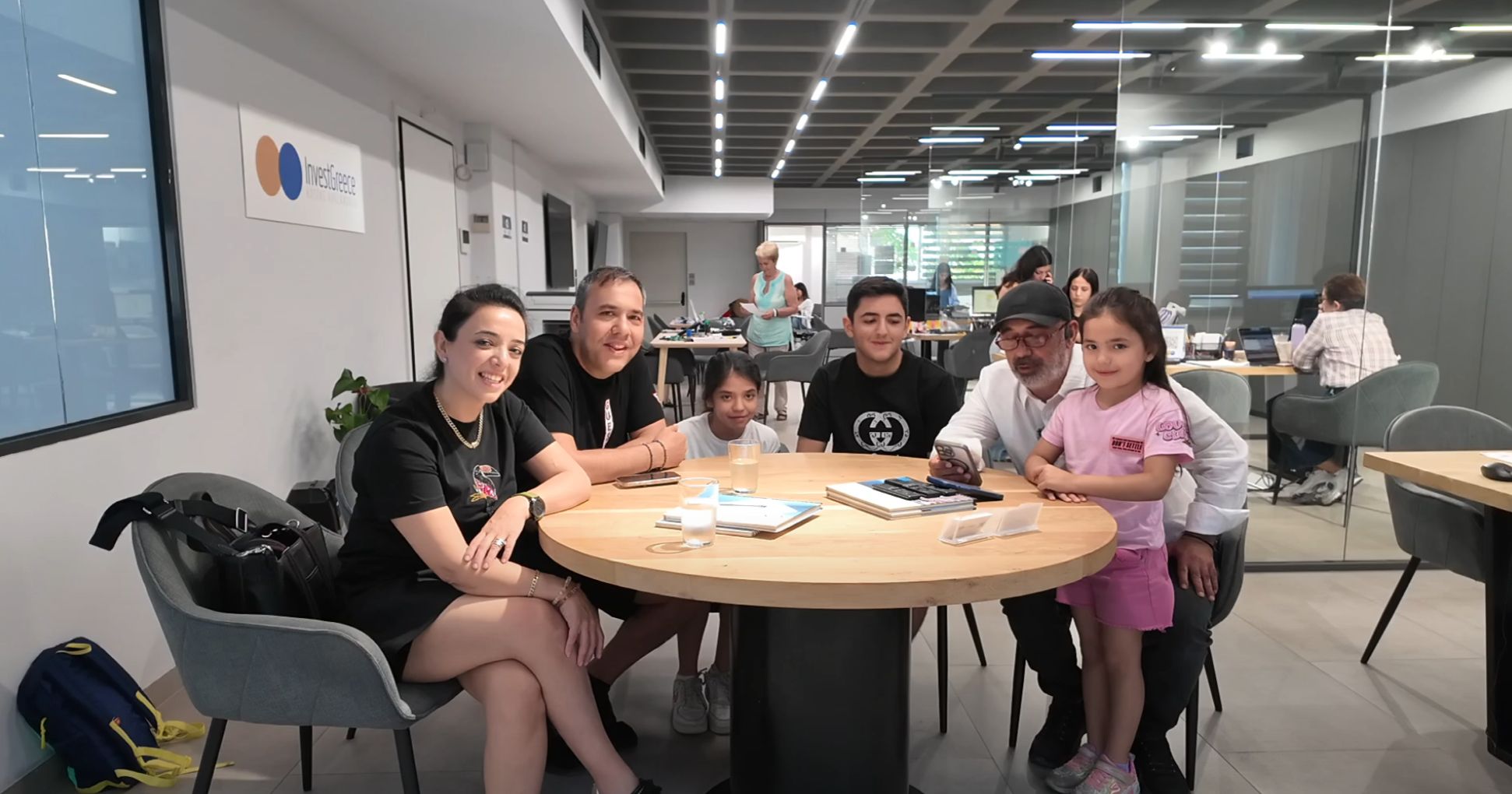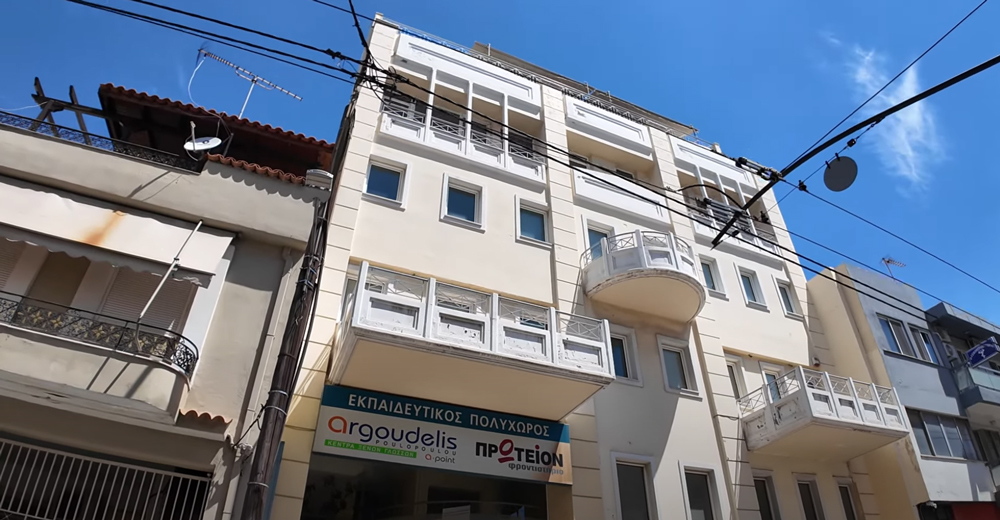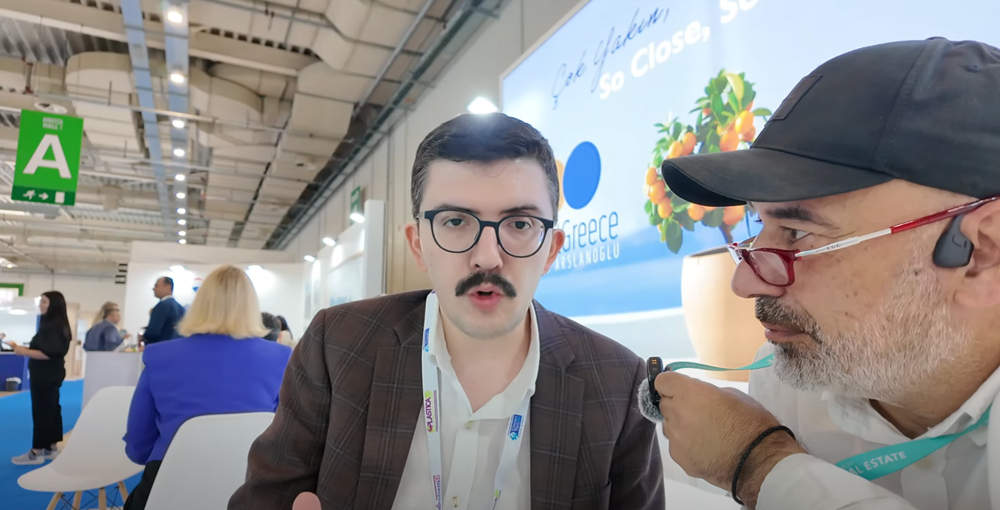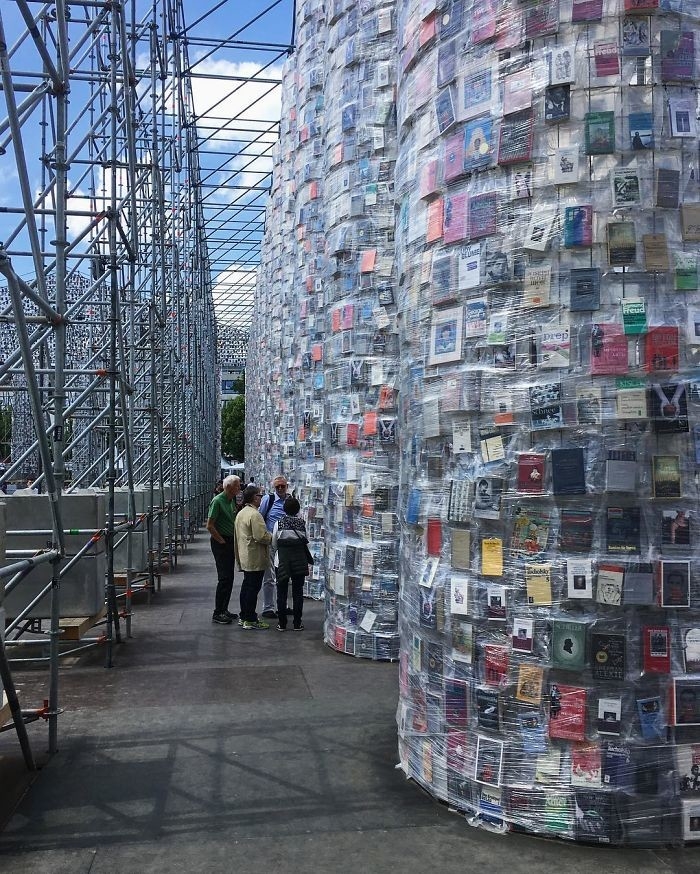
Arjantinli 74 yaşındaki sanatçı Marta Minujín, 100,000 yasaklı kitaptan, Yunanistan’daki Parthenon Tapınağı’nın tam boyutlu devasa bir replikasını yaptı. Sanatçıya göre bu çalışma, baskılara duyulan tepkiyi sembolize ediyor.
Üniversitesi öğrencilerinin katkılarıyla sanatçı Minujín, önce dünyanın her yerinden ülkelerde bir zamanlar yasaklanmış ya da halen yasaklı olan kitapları belirledi ve bu kitapları, plastik kaplamaları ve çeliği kullanarak tam boyutlu bu replikayı yarattı.
Ancak muhtemelen Almanya’nın en tartışmalı kitabı olan Adolf Hitler’in “Kavgam” isimli kitabı bu sanat eserinde yer almayacak. Ancak bunun için önemli bir gerekçesi var Marta Minujín’in: Dünyanın en ünlü sansürcüleri Nazilerdi. Hatta Minujín’in çalışması, çok geniş bir sansür kampanyasının bir parçası olarak 1933 yılında Nazilerin 2000’i kitabı yaktığı tarihi alanda yer alıyor. Heinrich Heine’in 19. yüzyılda dediği gibi, “Kitapları yaktıkları yerde, en sonunda insanları da yakarlar.”
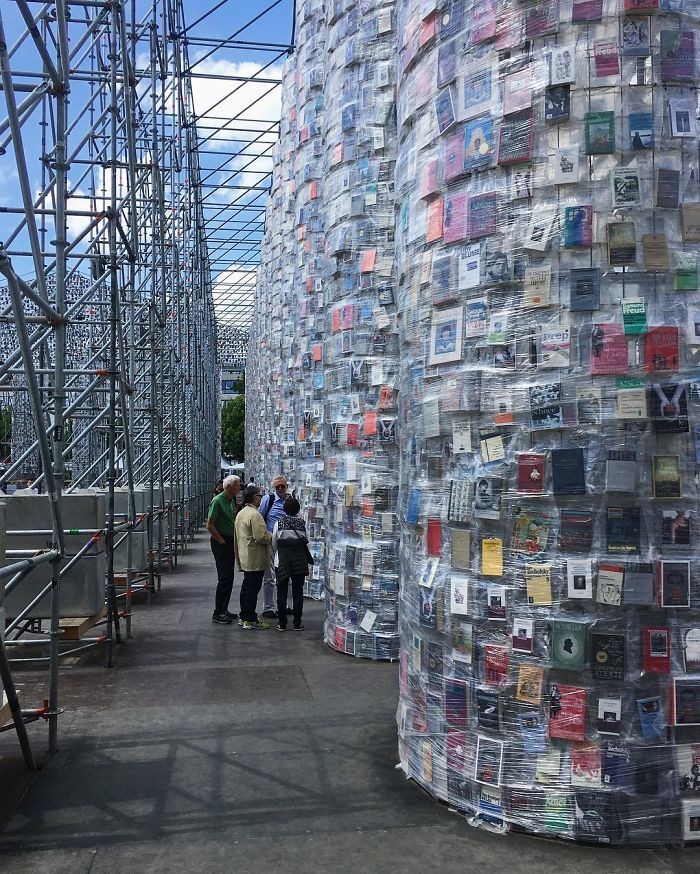
The Parthenon was built in Athens at the instigation of Pericles, under the supervision of the sculptor Phidias, between 447 and 38 BCE. The structure is ten meters high by seventy meters long and thirty meters wide. The temple was conceived to house a colossal gold statue of Athena, as well as the Delian League’s treasury and the city’s silver reserves—in the event of a Persian attack, these precious metals could be melted down and made into new coins to finance war. Transformed into a Christian church in the Middle Ages, then into a mosque during the Renaissance, the deconsecrated Parthenon of the modern period became a symbol of democracy and of Western cultural supremacy.
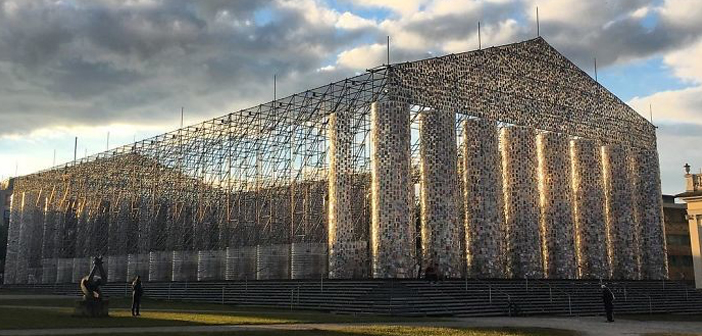
Marta Minujín, born in Buenos Aires in 1943, seized this aesthetic and political archetype of democracy for her own situation: corrupted by a “national Catholic” dictatorship that reigned in Argentina up until 1983, she put the democratic ideal back into circulation at the moment when the military junta fell. Her artistic project was part of her series “La caída de los mitos universals” or “The Fall of Universal Myths,” which appropriated monumental icons to replicate them, break them up into pieces, and redistribute them into the public realm. In a certain way, the artist gives back to these symbols—reified and confiscated by institutionalization or capitalization—their status as offerings. For El Partenón de libros (The Parthenon of Books, 1983), 25,000 books, taken from cellars where they had been locked up by the military, covered a scale replica of the Greek edifice; built out of metal tubes and elevated to one side, this Parthenon was placed in a public square in the southern part of Buenos Aires.
Minujín’s monuments to democracy and to education through art revive the ceremonies of archaic societies—contrary to the banning of books by the junta’s army and different from the privatization of public property that, through speculating on the debt of the state, encourages the suppression of public-sector services and creates social shortages. In her mass-participation projects, Minujín rediscovers the initial value of a collective treasure; she melts shared capital back down into cultural currency without remainder. She lays down the verticality of public edifices that embody confiscated cultural knowledge and a hidebound heritage. She dilapidates the fortune these myths represent. By literally tilting these symbols, Minujín not only gives new meaning to these monuments, she offers them a new sensuality.
—Pierre Bal-Blanc
Posted in Public Exhibition
Excerpted from the documenta 14: Daybook
Life and work of Minoujin
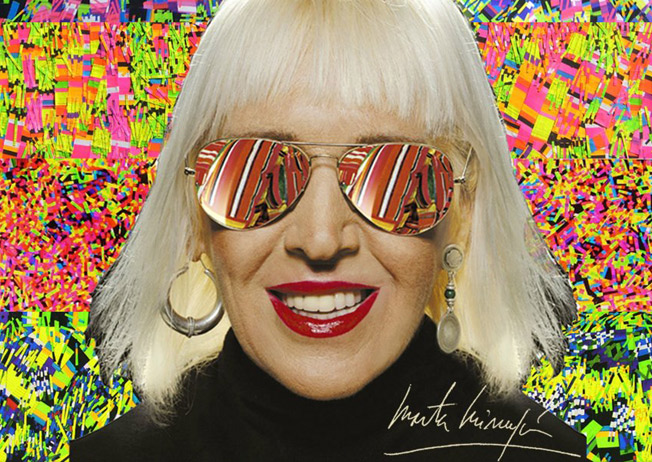
Marta Minujín was born in the San Telmo neighborhood of Buenos Aires. She met a young economist, Juan Carlos Gómez Sabaini, and married him in secret in 1959; the couple had two children. A student in the National University Art Institute, she first exhibited her work in a 1959 show at the Teatro Agón. A scholarship from the National Arts Foundation allowed her to travel to Paris as one of the young Argentine artists featured in Pablo Curatella Manes and Thirty Argentines of the New Generation, a 1960 exhibit organized by the prominent sculptor and Paris Biennale judge.[7]
Her time in Paris inspired her to create “livable sculptures,” notably La Destrucción, in which she assembled mattresses along the Impasse Roussin, only to invite other avant-garde artists in her entourage, including Christo and Paul-Armand Gette, to destroy the display. This 1963 creation would be the first of her “Happenings” – events as works of arts in themselves; among her hosts during her stay was Finance Minister Valéry Giscard d’Estaing (later President of France).[8]
She earned a National Award in 1964 at Buenos Aires’ Torcuato di Tella Institute, where she prepared two happenings: Eróticos en technicolor and the interactive Revuélquese y viva (Roll Around in Bed and Live). Her Cabalgata (Cavalcade) aired on Public Television that year, and involved horses with paint buckets tied to their tails. These displays took her to nearby Montevideo, where she organized Sucesos (Events) at the Uruguayan capital’s Tróccoli Stadium with 500 chickens, artists of contrasting physical shape, motorcycles, and other elements.[7]
She joined Rubén Santantonín at the di Tella Institute in 1965 to create La Menesunda (Mayhem), where participants were asked to go through sixteen chambers, each separated by a human-shaped entry. Led by neon lights, groups of eight visitors would encounter rooms with television sets at full blast, couples making love in bed, a cosmetics counter (complete with an attendant), a dental office from which dialing an oversized rotary phone was required to leave, a walk-in freezer with dangling fabrics (suggesting sides of beef), and a mirrored room with black lighting, falling confetti, and the scent of frying food. The use of advertising throughout suggested the influence of pop art in Minujín’s “mayhem.”[7]
These works earned her a Guggenheim Fellowship in 1966, by which she relocated to New York City. The coup d’état by General Juan Carlos Onganía in June of that year made her fellowship all the more fortuitous, as the new regime would frequently censor and ban irreverent displays such as hers. Minujín delved into psychedelic art in New York, of which among her best-known creations was that of the “Minuphone,” where patrons could enter a telephone booth, dial a number, and be surprised by colors projecting from the glass panels, sounds, and seeing themselves on a television screen in the floor.[9] She was on hand in 1971 for the Buenos Aires premiere of Operación Perfume, and in New York, befriended fellow conceptual artist Andy Warhol.[7]
She returned to Argentina in 1976, and afterwards created a series of reproductions of classical Greek sculptures in plaster of paris, as well as miniatures of the Buenos Aires Obelisk carved out of panettone, of the Venus de Milo carved from cheese, and of Tango vocalist Carlos Gardel for a 1981 display in Medellín. The latter, a sheet metal creation, was stuffed with cotton and lit, creating a metaphor for the legendary crooner’s untimely 1935 death in a Medellín plane crash.[8] She was awarded the first of a series of Konex Awards, the highest in the Argentine cultural realm, in 1982.[10]
The return of democracy in 1983, following seven years of a generally failed dictatorship, prompted Minujín to create a monument to a glaring, inanimate victim of the regime: freedom of expression. Assembling 30,000 banned books (including works as diverse as those by Freud, Marx, Sartre, Gramsci, Foucault, Raúl Scalabrini Ortiz, and Darcy Ribeiro, as well as satires such as Absalom and Achitophel, reference volumes such as Enciclopedia Salvat, and even children’s texts, notably The Little Prince by Antoine de Saint Exupéry), she designed the “Parthenon of Books,” and following President Raúl Alfonsín’s December 10 inaugural, had it mounted on a boulevard median along the Ninth of July Avenue. Dismantled after three weeks, its mass of newly unbanned titles was distributed to the public below.[8][11]
A conversation with Warhol in New York regarding the Latin American debt crisis inspired one of her most publicized “happenings:” The Debt. Purchasing a shipment of maize, Minujín dramatized the Argentine cost of servicing the foreign debt with a 1985 photo series in which she symbolically handed the maize to Warhol “in payment” for the debt; she never again saw Warhol, who died in 1987.[12]
Minujín has continued to display her art pieces and happenings in the Buenos Aires Museum of Modern Art, the National Fine Arts Museum, the ArteBA contemporary art festival Buenos Aires, the Barbican Center, and a vast number of other international galleries and art shows, while continuing to satirize consumer culture (particularly relating to women).[10][13] She is well known for her belief that “everything is art.” [7]

